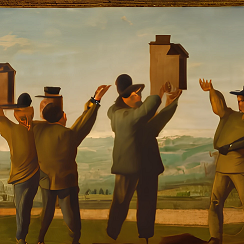Notes & Queries response - Why don’t the British respect service staff or builders the way they do abroad?
This is my response to a question that appeared on the Notes & Queries page of The Guardian website on the 5th March, 2023.
The Guardian is apparently no longer happy to host my comments on their site, so it is appearing here instead.This blog is obviously not affiliated with The Guardian. Its reference to a question that appeared in Notes & Queries is presented here under the terms of fair use.
~
Why don’t the British respect service staff or builders the way they do abroad?
 |
| image generated by Craiyon |
One point of origin can be traced back almost three centuries to Lady Margaret Elizabeth Yonge, who was a prominent social commentator during the reign of King George II. Lady Margaret certainly never laid a brick wall in her life. Were she alive today, she would undoubtedly belong to that breed of magazine socialite, who fill the wide gaps in their knowledge with the equally broad strokes of personal opinion. In her own time, she was feared and admired as a taste-maker supreme. Her edicts regarding the latest trends were widely parroted. As they rippled outward, through all strata of society, they rapidly assumed the dimensions of conventional wisdom.
Here is what she had to say about builders:
“I would not entrust the serried ranks of English builders to form a supporting wall with their own bodies, even if their lives, and those of their families, depended upon it. Any person with a shred of common sense knows that one should keep such brutes far apart from the materials of their trade, and instead extend invitation across the waters of the channel to those European craftsman who are of greatly superior proficiency.”
If it will help matters, you may picture Lady Margaret issuing her judgement before a party of assembled dinner guests at Yonge Hall, seated at the head of the table, on a chair discretely elevated two inches above the others; the white plume of her aigrette pinched against her temple; the scattered gemstones in the headband reflecting dappled light into the blinking, or lowered, eyes of her attentive listeners. She knew how to furnish a room to her advantage and how to command anyone who entered.
What had kindled such remarkable hatred of the English builder in the bosom of this trend-setting aristocrat? A distant ancestor had sown a forest on the family estate. It was called Priscilla Wood and it was intended to be temporary. Its founder left instructions that, upon reaching maturity, one hundred and fifty years hence, the trees should be cut down and the timber used in the expansion of the house. A builder by the name of Puttick was commissioned to carry out the work. He sold the home grown timber for a handsome profit and instead used poor quality reclaimed wood, taken from the warehouses that occupied the wharves around the cornered port of Hobin, in South Wales. (A cornered port is one that has been rendered obsolete by the development of a port nearby that occupies a more favourable position, in this instance the port of Greatland Wells.) To the chagrin of Lady Margaret, the new wing of Yonge Hall soon fell to ruin. Puttick disappeared off the face of the earth. There is some evidence that he emigrated to the Americas, though no record of what became of him has ever surfaced.
Lady Margaret's peculiar choice of imagery – of men forming supporting walls with their bodies – was probably informed by a tradition that once existed in some southern European countries, but that appears to have died out. During earthquakes, men would tightly interlock themselves together in human chains, holding up collapsing buildings long enough for women and children to escape, though often at the cost of their own lives. There is a particular way of doing this that infuses a line of interlaced human bodies with the combined ability to support a weight far greater than one would think was possible to bear. This practice is thought to have originated within the legions of the Roman Empire, though its roots remain sketchy.
Lady Margaret was greatly taken by the snail auctions that would occur spontaneously in Spanish markets. A builder would parade around a marketplace, bearing on his shoulders a meticulously-detailed, doll house-size replica of the property that he intended to construct. An opening called-out bid would begin the auction, which would then proceed with others, who had been lingering in the vicinity, making their own offers.
There was a dark side to this quaint convention: Generally, as soon as the first house had been completed, the same builder would auction a number of replicas, cutting corners and using cheaper materials, while charging the same price.
Lady Margaret went on a spending spree at the snail markets of Madrid just prior to the resumption of hostilities between England and Spain. She effectively led a small settlement worth of houses and their architects back across the English channel, to family-owned land in Somerset, where she established the town of Legott (now sadly in ruins having been flooded to form the Legott Reservoir).
Those contemporary builders who, with some justification, resent the tarnished image that has been bestowed upon them by Lady Margaret may take some pleasure in the knowledge that, after Yonge Hall burned down, in somewhat suspicious circumstances, no English builder would take on the task of the reconstruction. For two years, Lady Margaret occupied a large tent on the estate, until she was able to secure builders from the continent to carry out the work.
I hope this is of help.
 |
| image generated by Craiyon |



Comments
Post a Comment